Analyzing Monetary & Fiscal Policies in Economics for Managers
VerifiedAdded on 2023/05/28
|9
|1324
|274
Homework Assignment
AI Summary
This assignment delves into the effects of monetary and fiscal policies on an economy, particularly focusing on real GDP, potential GDP, inflation, and unemployment. It examines scenarios where the Federal Reserve intervenes to maintain GDP at its potential level, analyzing the use of contractionary policies like selling T-bills. The analysis extends to evaluating the impacts on aggregate demand and supply, price levels, and employment rates. Furthermore, the assignment explores the relationship between government spending, private and public savings, and interest rates, assessing how changes in these factors influence investment and economic equilibrium. The assignment also touches upon the complexities of international trade and sanctions, particularly in the context of oil prices and their impact on the US economy. Finally, it considers the effects of interest rate changes on investment and GDP in both closed and open economies, providing a comprehensive overview of macroeconomic principles and their practical applications.
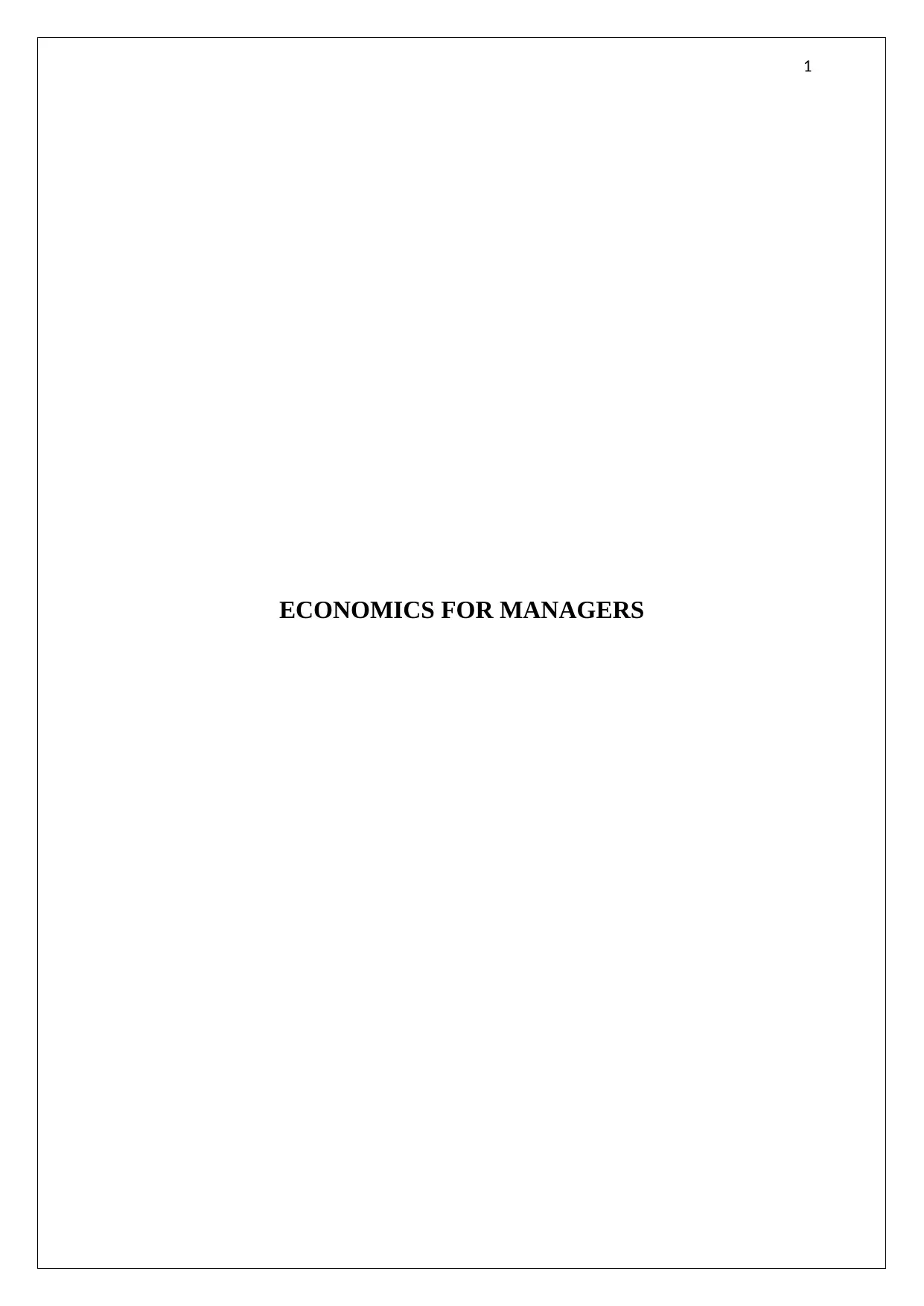
1
ECONOMICS FOR MANAGERS
ECONOMICS FOR MANAGERS
Paraphrase This Document
Need a fresh take? Get an instant paraphrase of this document with our AI Paraphraser
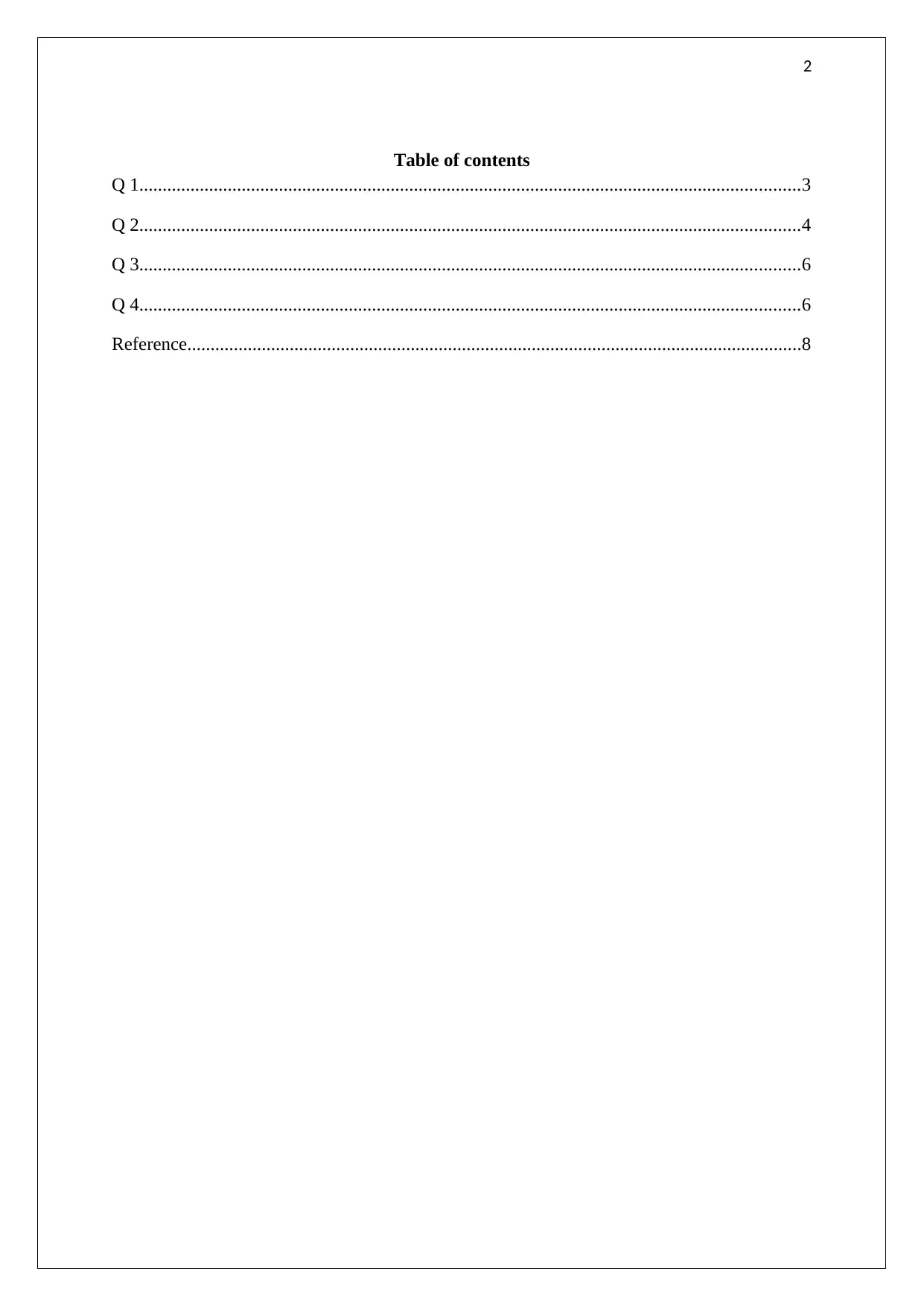
2
Table of contents
Q 1..............................................................................................................................................3
Q 2..............................................................................................................................................4
Q 3..............................................................................................................................................6
Q 4..............................................................................................................................................6
Reference....................................................................................................................................8
Table of contents
Q 1..............................................................................................................................................3
Q 2..............................................................................................................................................4
Q 3..............................................................................................................................................6
Q 4..............................................................................................................................................6
Reference....................................................................................................................................8
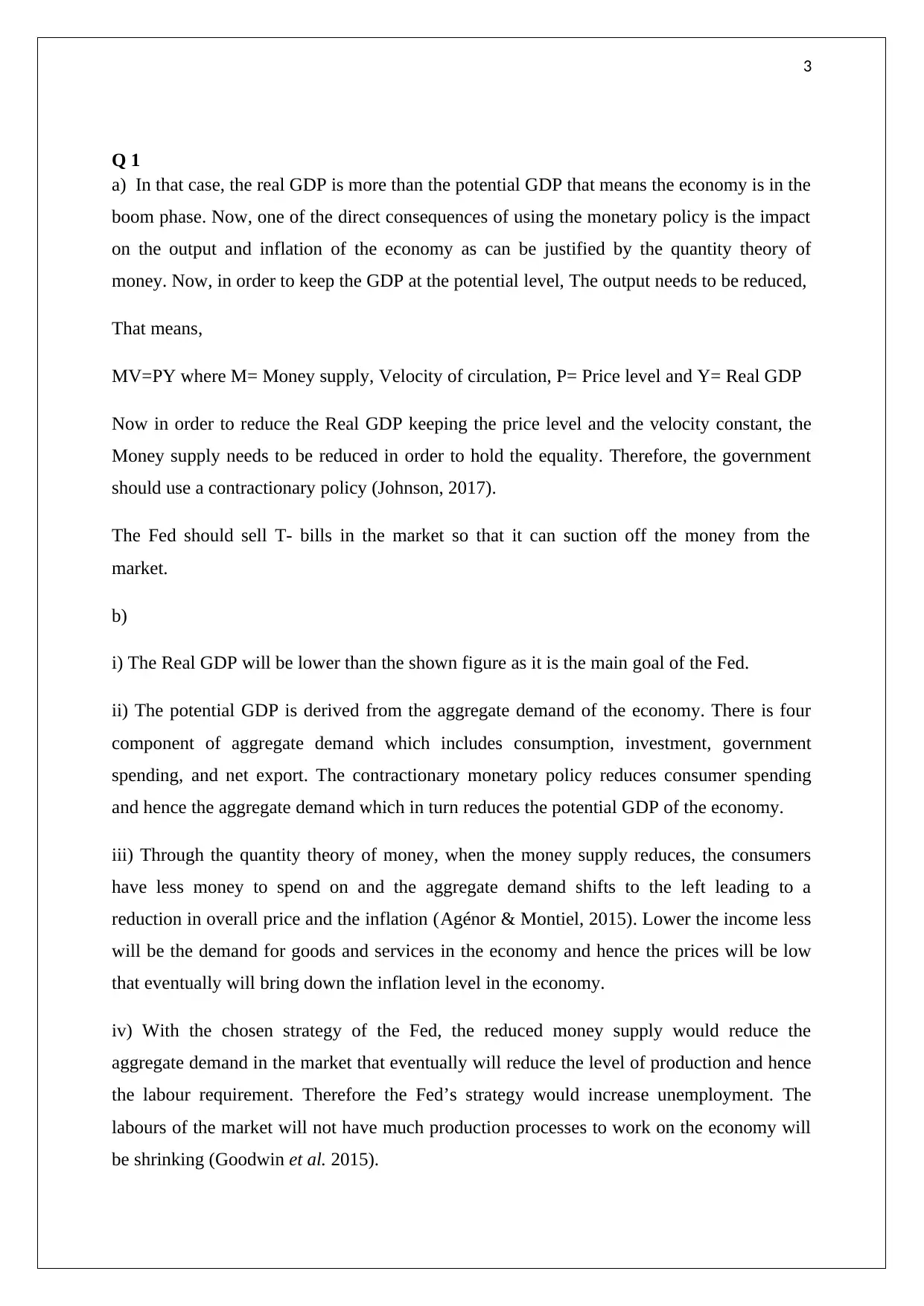
3
Q 1
a) In that case, the real GDP is more than the potential GDP that means the economy is in the
boom phase. Now, one of the direct consequences of using the monetary policy is the impact
on the output and inflation of the economy as can be justified by the quantity theory of
money. Now, in order to keep the GDP at the potential level, The output needs to be reduced,
That means,
MV=PY where M= Money supply, Velocity of circulation, P= Price level and Y= Real GDP
Now in order to reduce the Real GDP keeping the price level and the velocity constant, the
Money supply needs to be reduced in order to hold the equality. Therefore, the government
should use a contractionary policy (Johnson, 2017).
The Fed should sell T- bills in the market so that it can suction off the money from the
market.
b)
i) The Real GDP will be lower than the shown figure as it is the main goal of the Fed.
ii) The potential GDP is derived from the aggregate demand of the economy. There is four
component of aggregate demand which includes consumption, investment, government
spending, and net export. The contractionary monetary policy reduces consumer spending
and hence the aggregate demand which in turn reduces the potential GDP of the economy.
iii) Through the quantity theory of money, when the money supply reduces, the consumers
have less money to spend on and the aggregate demand shifts to the left leading to a
reduction in overall price and the inflation (Agénor & Montiel, 2015). Lower the income less
will be the demand for goods and services in the economy and hence the prices will be low
that eventually will bring down the inflation level in the economy.
iv) With the chosen strategy of the Fed, the reduced money supply would reduce the
aggregate demand in the market that eventually will reduce the level of production and hence
the labour requirement. Therefore the Fed’s strategy would increase unemployment. The
labours of the market will not have much production processes to work on the economy will
be shrinking (Goodwin et al. 2015).
Q 1
a) In that case, the real GDP is more than the potential GDP that means the economy is in the
boom phase. Now, one of the direct consequences of using the monetary policy is the impact
on the output and inflation of the economy as can be justified by the quantity theory of
money. Now, in order to keep the GDP at the potential level, The output needs to be reduced,
That means,
MV=PY where M= Money supply, Velocity of circulation, P= Price level and Y= Real GDP
Now in order to reduce the Real GDP keeping the price level and the velocity constant, the
Money supply needs to be reduced in order to hold the equality. Therefore, the government
should use a contractionary policy (Johnson, 2017).
The Fed should sell T- bills in the market so that it can suction off the money from the
market.
b)
i) The Real GDP will be lower than the shown figure as it is the main goal of the Fed.
ii) The potential GDP is derived from the aggregate demand of the economy. There is four
component of aggregate demand which includes consumption, investment, government
spending, and net export. The contractionary monetary policy reduces consumer spending
and hence the aggregate demand which in turn reduces the potential GDP of the economy.
iii) Through the quantity theory of money, when the money supply reduces, the consumers
have less money to spend on and the aggregate demand shifts to the left leading to a
reduction in overall price and the inflation (Agénor & Montiel, 2015). Lower the income less
will be the demand for goods and services in the economy and hence the prices will be low
that eventually will bring down the inflation level in the economy.
iv) With the chosen strategy of the Fed, the reduced money supply would reduce the
aggregate demand in the market that eventually will reduce the level of production and hence
the labour requirement. Therefore the Fed’s strategy would increase unemployment. The
labours of the market will not have much production processes to work on the economy will
be shrinking (Goodwin et al. 2015).
⊘ This is a preview!⊘
Do you want full access?
Subscribe today to unlock all pages.

Trusted by 1+ million students worldwide

4
c)
Figure 1: the aggregate demand and supply of the market
(Source: Developed by the learner)
Q 2
a)
The equation is
Y= C+I+G
Now the private savings,
Y –T-C
Putting the values,
5000-1000-250-0.75(Y-T)= 3750-0.75(5000-1000) = 750
The public savings,
T-G= 1000-1000= 0
c)
Figure 1: the aggregate demand and supply of the market
(Source: Developed by the learner)
Q 2
a)
The equation is
Y= C+I+G
Now the private savings,
Y –T-C
Putting the values,
5000-1000-250-0.75(Y-T)= 3750-0.75(5000-1000) = 750
The public savings,
T-G= 1000-1000= 0
Paraphrase This Document
Need a fresh take? Get an instant paraphrase of this document with our AI Paraphraser
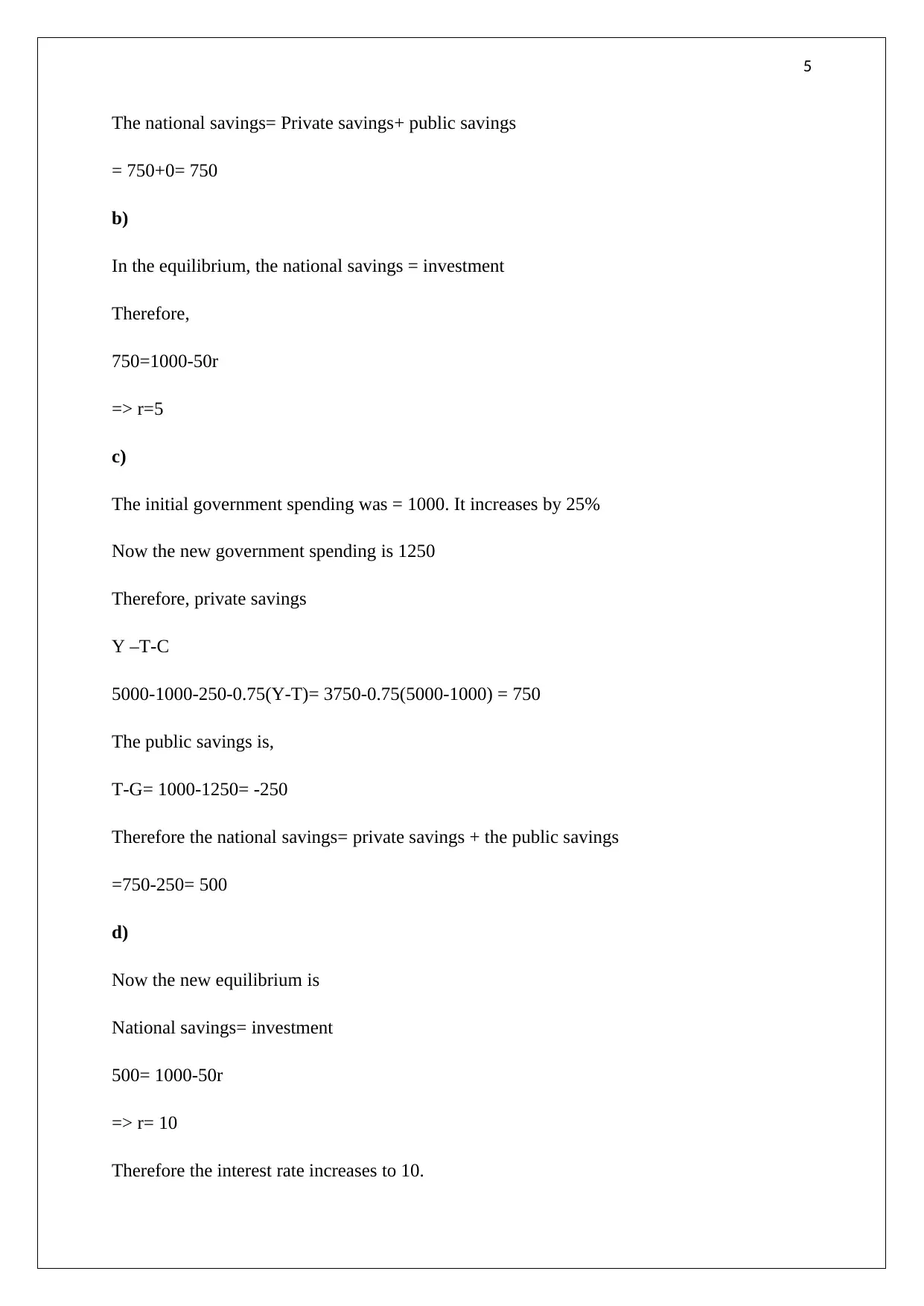
5
The national savings= Private savings+ public savings
= 750+0= 750
b)
In the equilibrium, the national savings = investment
Therefore,
750=1000-50r
=> r=5
c)
The initial government spending was = 1000. It increases by 25%
Now the new government spending is 1250
Therefore, private savings
Y –T-C
5000-1000-250-0.75(Y-T)= 3750-0.75(5000-1000) = 750
The public savings is,
T-G= 1000-1250= -250
Therefore the national savings= private savings + the public savings
=750-250= 500
d)
Now the new equilibrium is
National savings= investment
500= 1000-50r
=> r= 10
Therefore the interest rate increases to 10.
The national savings= Private savings+ public savings
= 750+0= 750
b)
In the equilibrium, the national savings = investment
Therefore,
750=1000-50r
=> r=5
c)
The initial government spending was = 1000. It increases by 25%
Now the new government spending is 1250
Therefore, private savings
Y –T-C
5000-1000-250-0.75(Y-T)= 3750-0.75(5000-1000) = 750
The public savings is,
T-G= 1000-1250= -250
Therefore the national savings= private savings + the public savings
=750-250= 500
d)
Now the new equilibrium is
National savings= investment
500= 1000-50r
=> r= 10
Therefore the interest rate increases to 10.
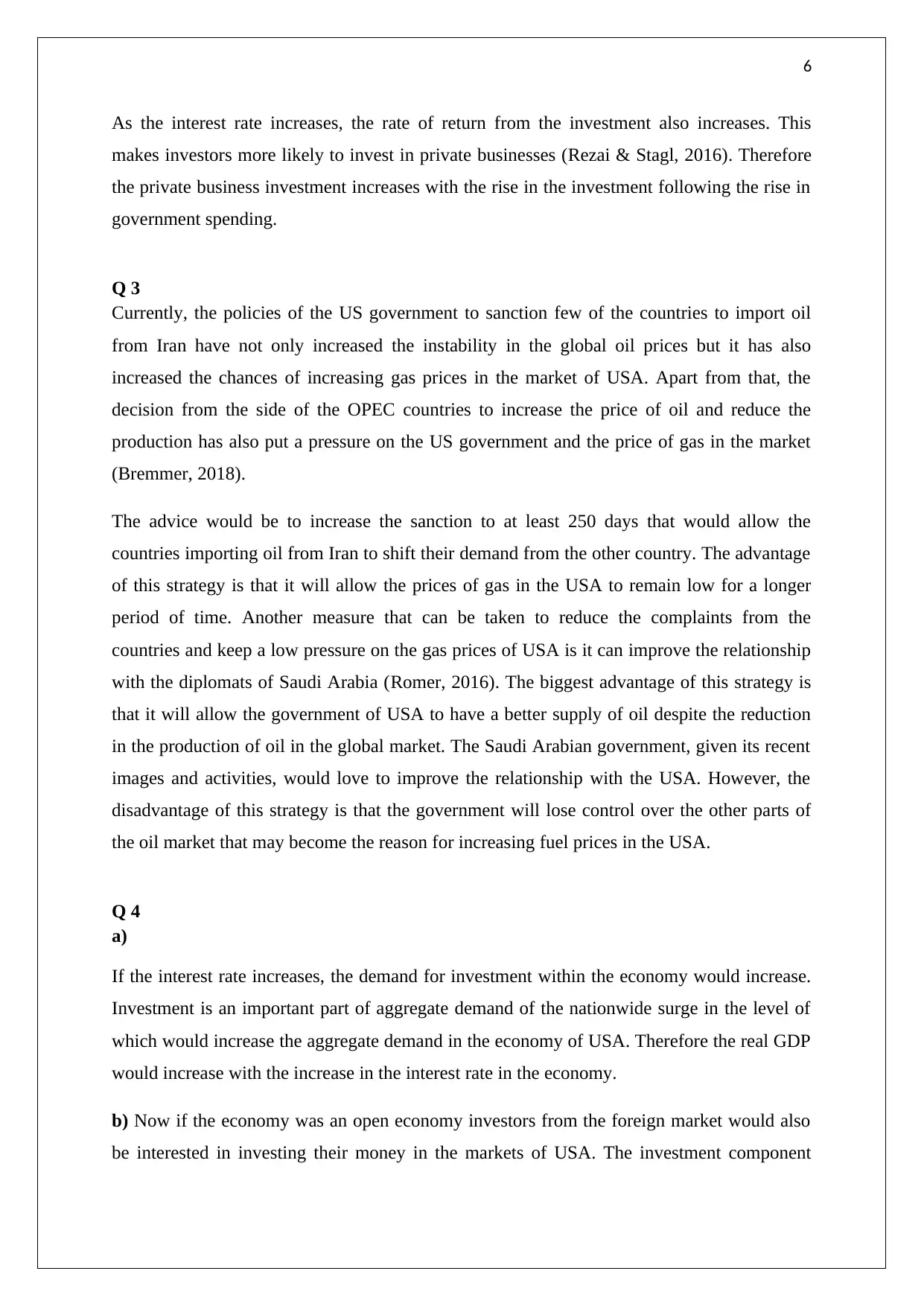
6
As the interest rate increases, the rate of return from the investment also increases. This
makes investors more likely to invest in private businesses (Rezai & Stagl, 2016). Therefore
the private business investment increases with the rise in the investment following the rise in
government spending.
Q 3
Currently, the policies of the US government to sanction few of the countries to import oil
from Iran have not only increased the instability in the global oil prices but it has also
increased the chances of increasing gas prices in the market of USA. Apart from that, the
decision from the side of the OPEC countries to increase the price of oil and reduce the
production has also put a pressure on the US government and the price of gas in the market
(Bremmer, 2018).
The advice would be to increase the sanction to at least 250 days that would allow the
countries importing oil from Iran to shift their demand from the other country. The advantage
of this strategy is that it will allow the prices of gas in the USA to remain low for a longer
period of time. Another measure that can be taken to reduce the complaints from the
countries and keep a low pressure on the gas prices of USA is it can improve the relationship
with the diplomats of Saudi Arabia (Romer, 2016). The biggest advantage of this strategy is
that it will allow the government of USA to have a better supply of oil despite the reduction
in the production of oil in the global market. The Saudi Arabian government, given its recent
images and activities, would love to improve the relationship with the USA. However, the
disadvantage of this strategy is that the government will lose control over the other parts of
the oil market that may become the reason for increasing fuel prices in the USA.
Q 4
a)
If the interest rate increases, the demand for investment within the economy would increase.
Investment is an important part of aggregate demand of the nationwide surge in the level of
which would increase the aggregate demand in the economy of USA. Therefore the real GDP
would increase with the increase in the interest rate in the economy.
b) Now if the economy was an open economy investors from the foreign market would also
be interested in investing their money in the markets of USA. The investment component
As the interest rate increases, the rate of return from the investment also increases. This
makes investors more likely to invest in private businesses (Rezai & Stagl, 2016). Therefore
the private business investment increases with the rise in the investment following the rise in
government spending.
Q 3
Currently, the policies of the US government to sanction few of the countries to import oil
from Iran have not only increased the instability in the global oil prices but it has also
increased the chances of increasing gas prices in the market of USA. Apart from that, the
decision from the side of the OPEC countries to increase the price of oil and reduce the
production has also put a pressure on the US government and the price of gas in the market
(Bremmer, 2018).
The advice would be to increase the sanction to at least 250 days that would allow the
countries importing oil from Iran to shift their demand from the other country. The advantage
of this strategy is that it will allow the prices of gas in the USA to remain low for a longer
period of time. Another measure that can be taken to reduce the complaints from the
countries and keep a low pressure on the gas prices of USA is it can improve the relationship
with the diplomats of Saudi Arabia (Romer, 2016). The biggest advantage of this strategy is
that it will allow the government of USA to have a better supply of oil despite the reduction
in the production of oil in the global market. The Saudi Arabian government, given its recent
images and activities, would love to improve the relationship with the USA. However, the
disadvantage of this strategy is that the government will lose control over the other parts of
the oil market that may become the reason for increasing fuel prices in the USA.
Q 4
a)
If the interest rate increases, the demand for investment within the economy would increase.
Investment is an important part of aggregate demand of the nationwide surge in the level of
which would increase the aggregate demand in the economy of USA. Therefore the real GDP
would increase with the increase in the interest rate in the economy.
b) Now if the economy was an open economy investors from the foreign market would also
be interested in investing their money in the markets of USA. The investment component
⊘ This is a preview!⊘
Do you want full access?
Subscribe today to unlock all pages.

Trusted by 1+ million students worldwide
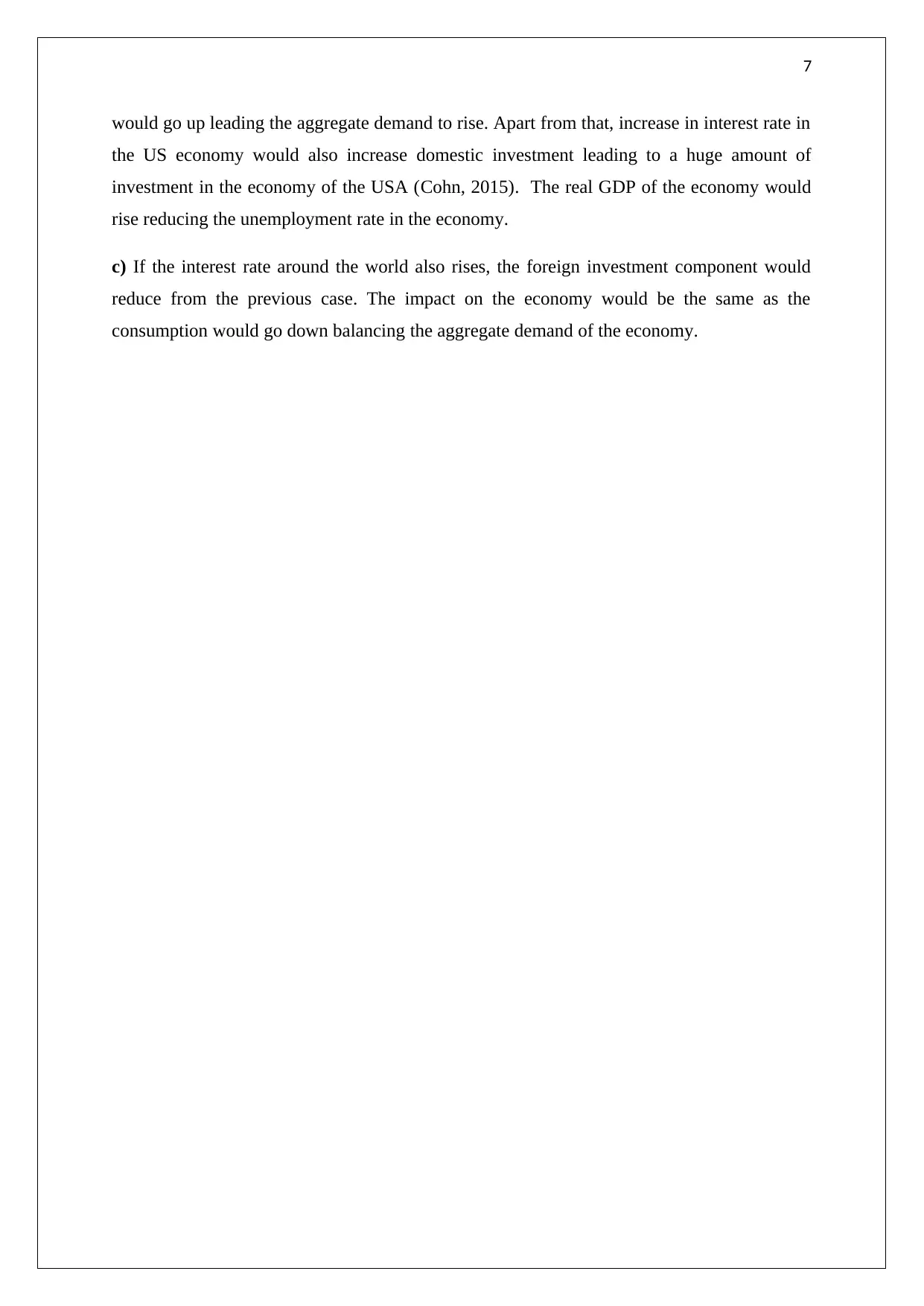
7
would go up leading the aggregate demand to rise. Apart from that, increase in interest rate in
the US economy would also increase domestic investment leading to a huge amount of
investment in the economy of the USA (Cohn, 2015). The real GDP of the economy would
rise reducing the unemployment rate in the economy.
c) If the interest rate around the world also rises, the foreign investment component would
reduce from the previous case. The impact on the economy would be the same as the
consumption would go down balancing the aggregate demand of the economy.
would go up leading the aggregate demand to rise. Apart from that, increase in interest rate in
the US economy would also increase domestic investment leading to a huge amount of
investment in the economy of the USA (Cohn, 2015). The real GDP of the economy would
rise reducing the unemployment rate in the economy.
c) If the interest rate around the world also rises, the foreign investment component would
reduce from the previous case. The impact on the economy would be the same as the
consumption would go down balancing the aggregate demand of the economy.
Paraphrase This Document
Need a fresh take? Get an instant paraphrase of this document with our AI Paraphraser
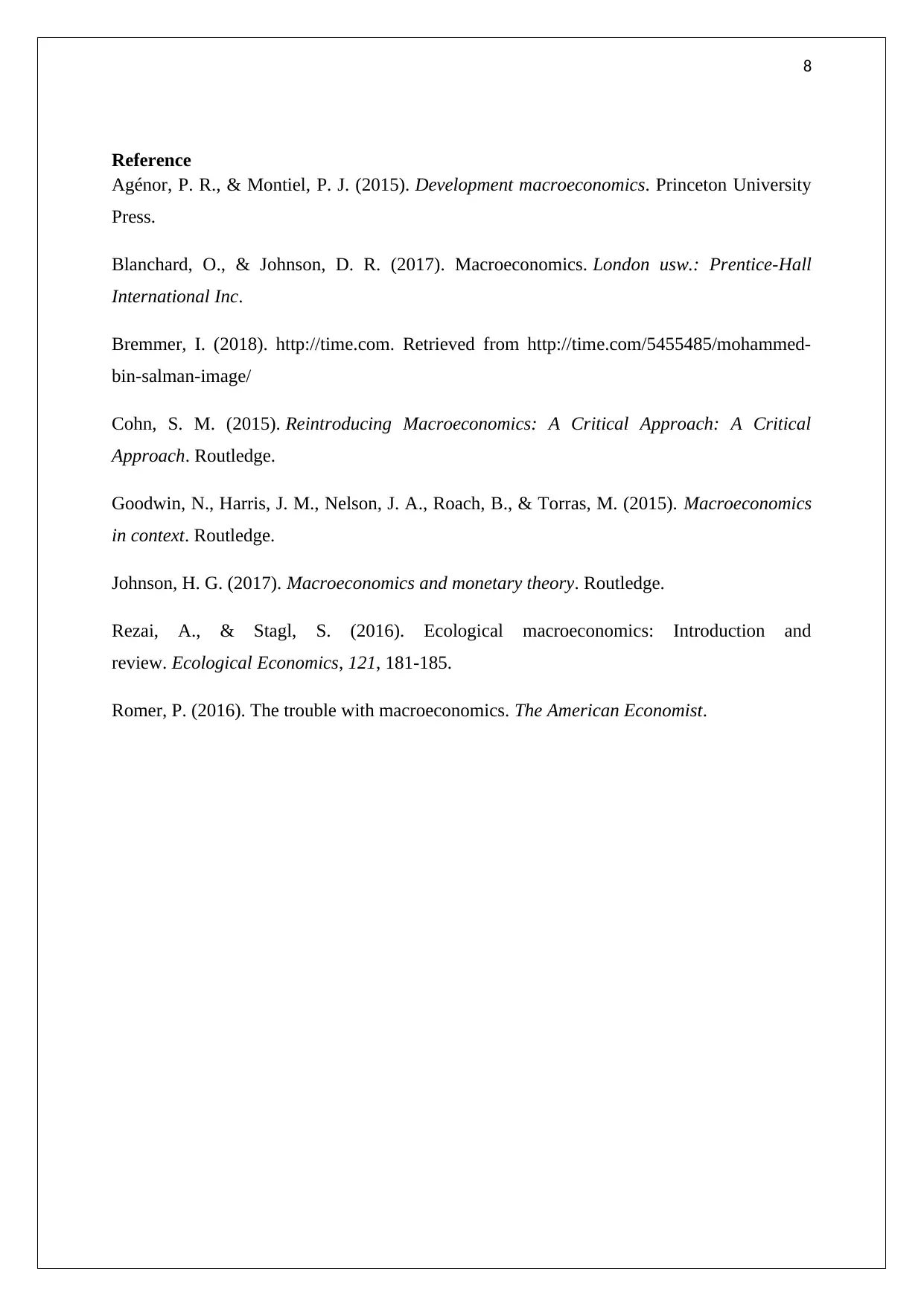
8
Reference
Agénor, P. R., & Montiel, P. J. (2015). Development macroeconomics. Princeton University
Press.
Blanchard, O., & Johnson, D. R. (2017). Macroeconomics. London usw.: Prentice-Hall
International Inc.
Bremmer, I. (2018). http://time.com. Retrieved from http://time.com/5455485/mohammed-
bin-salman-image/
Cohn, S. M. (2015). Reintroducing Macroeconomics: A Critical Approach: A Critical
Approach. Routledge.
Goodwin, N., Harris, J. M., Nelson, J. A., Roach, B., & Torras, M. (2015). Macroeconomics
in context. Routledge.
Johnson, H. G. (2017). Macroeconomics and monetary theory. Routledge.
Rezai, A., & Stagl, S. (2016). Ecological macroeconomics: Introduction and
review. Ecological Economics, 121, 181-185.
Romer, P. (2016). The trouble with macroeconomics. The American Economist.
Reference
Agénor, P. R., & Montiel, P. J. (2015). Development macroeconomics. Princeton University
Press.
Blanchard, O., & Johnson, D. R. (2017). Macroeconomics. London usw.: Prentice-Hall
International Inc.
Bremmer, I. (2018). http://time.com. Retrieved from http://time.com/5455485/mohammed-
bin-salman-image/
Cohn, S. M. (2015). Reintroducing Macroeconomics: A Critical Approach: A Critical
Approach. Routledge.
Goodwin, N., Harris, J. M., Nelson, J. A., Roach, B., & Torras, M. (2015). Macroeconomics
in context. Routledge.
Johnson, H. G. (2017). Macroeconomics and monetary theory. Routledge.
Rezai, A., & Stagl, S. (2016). Ecological macroeconomics: Introduction and
review. Ecological Economics, 121, 181-185.
Romer, P. (2016). The trouble with macroeconomics. The American Economist.
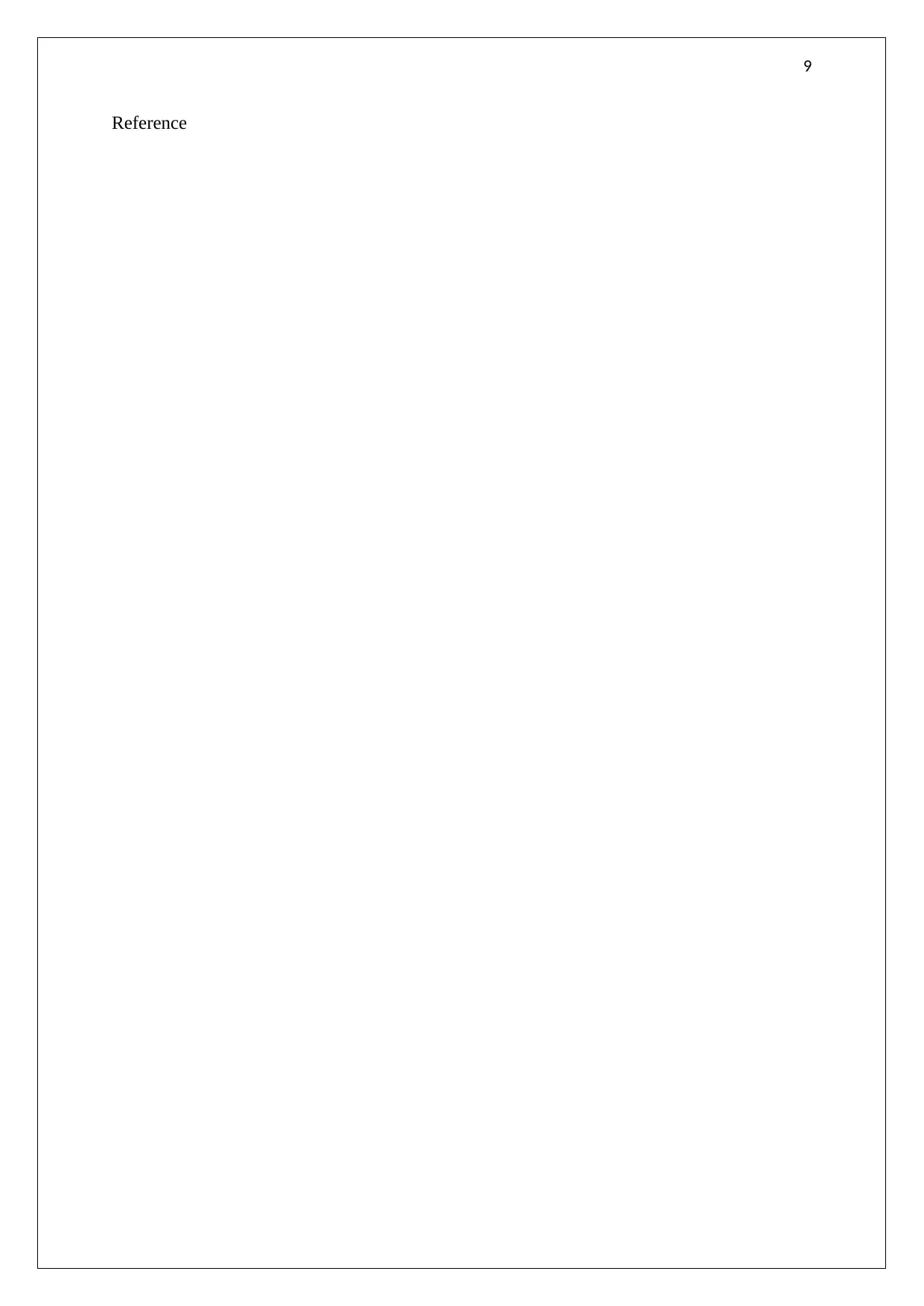
9
Reference
Reference
⊘ This is a preview!⊘
Do you want full access?
Subscribe today to unlock all pages.

Trusted by 1+ million students worldwide
1 out of 9
Related Documents
Your All-in-One AI-Powered Toolkit for Academic Success.
+13062052269
info@desklib.com
Available 24*7 on WhatsApp / Email
![[object Object]](/_next/static/media/star-bottom.7253800d.svg)
Unlock your academic potential
Copyright © 2020–2025 A2Z Services. All Rights Reserved. Developed and managed by ZUCOL.





